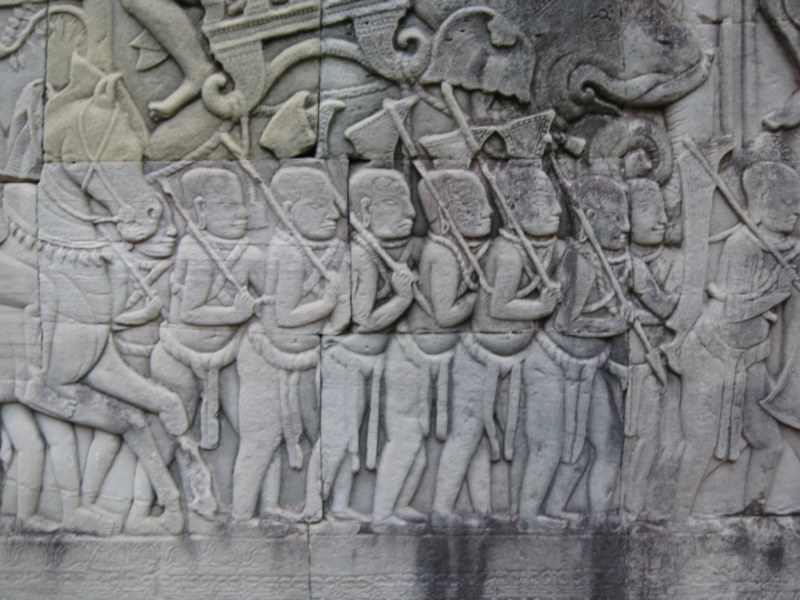Can you miss Angkor Wat?
You cannot go to Cambodia and not see Angkor Wat, Suzanne responded, wide eyed and incredulous that I could even think about it. But I wasn’t so sure. Maybe it was the tourist thing. I don’t like being shown around by a guide, the same inane chatter, the same non- information, the same inability to answer any question with any depth, the air conditioned car, the inevitable tourist traps; the souvenir sellers -the same whiny pleading tone, just one dollar mister, look 10 post card – one dollar, the feelings of guilt – the amputees, the exploitation of it all.
Don’t get me wrong. Angkor Wat is part of a truly magnificent and beautiful complex of temples that was hidden away in the jungle for many years until rediscovered by the French archaeologist, Henri Mouhot in 1859. It is a candidate for the 10th wonder of the modern world, the advertising posters proclaimed. Some of the temples, particularly the Roulos group and Bateus Reay are so lovely especially when viewed in the evening when most of the tourists have gone, the sun is low in the sky and birds are singing – mellow russet stones amid the dense green foliage. And then there’s the Jungle Temple, its walls and columns completely overwhelmed by the giant muscular roots of strangler figs, a mysterious and eerie setting for the film Tomb Raider starring Angelina Jolie.
Angkor Wat is not so much a church but a house for the Gods. There are no big spaces. People just walk round and visit, maybe talk to the monks. The carved friezes on the outer wall depict scenes from the Ramayana as well as beautiful illustrations of everyday life ten centuries ago.
I always marvel at the sheer complexity and sophistication of life so long ago. It reminds me of the triumphant columns of ancient Rome, the reliefs on the Temple in the Valley of the Kings in Egypt or the magnificent Assyrian reliefs in the British Museum, but you need time to reflect on such things away from the press of tourists and the self congratulatory chatter of Nak, our increasingly irritating guide. ‘I am very fit, I love fast cars, I go cycling. I cycle back to Siem Riep in 20 minutes.’ Oh really, that’s very good, I reply for the umpteenth time, hoping he might just pick up the note of sarcasm in my voice and desist. But he’s completely oblivious. ‘I very strong and handsome. I love beautiful women.’ ‘You rascal, you.’
And then there are the terraces of the Leper King (so named because his image has been overgrown with moss and bits of toes and earlobes are missing) and of the Elephants in Angkor Thom. These are situated at the edge of a massive arena, larger even than the Circus Maximus in Rome and dominated by massive carvings of Garuda (which until now I thought was just the name of the Indonesian airline).
What is interesting is not the differences of the Angkor Wat complex, but the connections, the similarities with other cultures; ancient Rome, classical Greece, the Egypt of the pharaohs, the Tigris- Euphrates valley, and of course numerous sites in India. It’s like convergent evolution; the same patterning is built into human culture but may come to fruition at different times without any obvious link between them. But could the Khmer kingdom have been aware of classical western civilisations? Might there have been a link through India; Alexander the Great? It makes you think, but you have to have time to think. You need the mental space to discover things for yourself, to pause and reflect. Another group of flag waving, chattering Korean tourists completely negates that. But Nak was getting the message.
So I now know what the Nagas are and appreciate that the churning of the sea of milk by the Gods pulling on opposing nagas around Mount Meru threw up all kinds of mythical creatures including the beautiful half Goddess Apsara dancers. I understand how each ritualised step of the Apsara dance carries a particular emotional significance. I know about conflicts of Vishnu in his incarnation as a monkey general against the demons. But I struggle to find any deeper significance in these myths. So they’re relegated to the back burner. I know about the life of Buddha, his birth into privilege, his marriage to a princess, the great renunciation, the long years of meditation under the Boddihava Tree until he attained the beatific state of Nirvana. I find out that Angkor Wat was a garrison for the Khmer Rouge and another temple a field hospital. I understand how the temple complex was built between the 8th and 12th centuries by workers in exchange for their food and lodging and that there were only 4 classes of people at the time; soldiers, farmers, workers and monks – a bit like in mediaeval England. Facts at the periphery of awareness become fleshed out awaiting further enlightenment.
But I guess that’s what travel is about, opening the mind to possibilities, doing some work to try and understand the context, associations and meanings; a voyage of self discovery. I’m afraid a guided tour can prevent that. It’s a bit like eating fast food; it disempowers and is not very nourishing, but if time is short, it can at least provide an awareness for further study . So despite Nak, twenty thousand Koreans and Japanese, the whining post card sellers, the guilt at being a rich tourist bastard, I guess this was a positive experience. Next time I shall do it free lance and on a bike.



